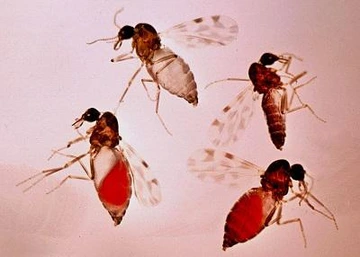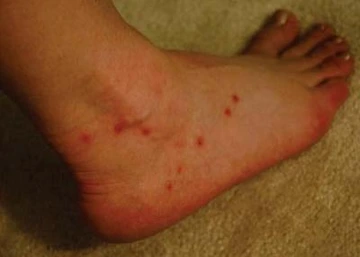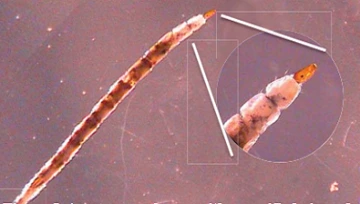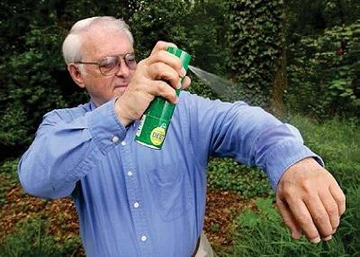Introduction
Summer brings a lot of insect activity, and many people experience bites. Some of these are from insects that can be seen, for example, mosquitoes. However, sometimes all that can be seen are the bites, leaving the affected persons wondering what bit them. Occasionally people are aware of small insects flying around them, but do not actually see them biting. These bites may be from small biting midges, often called “no-see-ums”. They are also known as punkies or sand flies.
No-see-ums in Arizona mostly belong to the genus Culicoides, in the family Certopogonidae. They belong to the insect order Diptera, which also includes mosquitoes, midges and other biting and non-biting flies.
Appearance
The adults are small, dark flies, 1/8th to 1/4th inch in length, barely visible to the naked eye. They have short, stocky bodies with a shiny thorax (back) (Figure 1). On close observation or under a microscope, they may appear like miniature mosquitoes (Figure 2).

Figure 1. Adult no-see-um biting midge

Figure 2. Adult no-see-um biting viewed through a microscope
Biting concerns
Adult females need blood meals for their eggs to develop. Both males and females feed on pollen and nectar, but the males are not a biting concern to humans or other animals. The females feed on blood from various host animals including humans and cause painful and irritating bites, that may be accompanied by allergic reactions.
Bites usually appear as small red welts (about 1/8 th inch in diameter ) or water-filled blisters, that itch intensely (Figure 3). The welts or blisters can break open and bleed on scratching, and the itching may continue. Sensitive persons may develop long-lasting painful and itchy lesions.

Figure 3. No-see-um bites on may appear as small red welts
Vectors
Some of the blood-feeding species vector pathogens including bacteria, viruses, protozoa and filarial worms. Bites from Culicoides spp. are known to cause an allergic reaction known as ‘sweet itch’ in horses. One species (Culicoides sonorensis) is known to transmit the bluetongue virus, a serious disease of sheep and cattle.
No-see-ums are seen in largest numbers in the summer, but in places with warm winters, they can occur year-round. They are usually active during dawn or dusk, and often go unnoticed owing to their small size. Both sexes cause great annoyance during outdoor activities, in almost any habitat near water sources such as near springs, ponds or lakes, river banks, beaches, and swamps. They are also reported from plains as well as mountain areas. In urban areas, they can breed in any muddy or moist location, such as over-irrigated mulch or sod, tree holes, new construction sites, indoor plant pots, and even water from air-conditioners.
Life cycle
Eggs are laid in dark, damp locations with rich organic matter. Any location inside or outside buildings that has moist organic matter can serve as a breeding site (Figure 4). Eggs hatch in 2-10 days. Larvae are equipped with specialized brush-like breathing tubes on their heads (Figure 5), enabling them to lead a semi-aquatic life, feeding on organic matter. They cannot survive a total lack of moisture or more than 2 inches of water, but will pupate in drier spots. Duration of each stage and the total life cycle varies widely with the species and environmental conditions and might range from 2-6 weeks. Males typically pupate faster than females. Females may disperse a little over 1 mile in distance from where they emerge, but high numbers of bites are likely to be experienced very close to emergence locations.

Figure 5. A no-see-um larva, with magnified view of head region, showing breathing tube Photo Credit: Erin Hayes-Ponitius
Owing to their minute size, no-see-ums can easily pass through ordinary insect screens on doors and windows, and will occasionally bite people indoors.
Managing No-See-Ums
Reduce breeding sites: Common breeding sites in community environments include over-irrigated turf and landscapes (Figure 6), splash pads (Figure 7) and poorly drained areas in parks and grounds, as well as indoor potted plants. If high numbers of bites are observed, hold off irrigation in the vicinity and allow moist spots to drain and dry. This will kill eggs and larvae.

Figure 6. Over-irrigated turf provides breeding sites for no-see-ums

Figure 7. Splash pads are great ways to cool off in the summer, but if improperly drained, they can accumulate water around and underneath.
Use protective clothing: Wear light colored long-sleeved shirts, pants, shoes and socks, and hats with fine mesh netting to cover the face and neck when engaging in outdoor activities, particularly in areas where no-see-ums are likely to occur.
Use insect repellents: Repellents effective against mosquitos are effective against biting midges. Choose a suitable repellent (Read more at https://extension.arizona.edu/sites/extension.arizona.edu/files/pubs/az1761-2018.pdf and always follow the label instructions when using repellents (Figure 8).
Use pest exclusion: Keep doors and windows screened and shut as much as possible, and avoid propping doors open. No-see-ums can pass through standard 16 x 16 or 18 x16 mesh screens, so replace these with smaller mesh (30 x 30) wherever possible. Inspect screens periodically and repair any rips or gaps.

Figure 8. Always wear long-sleeved shirts and use insect repellents when engaging in outdoor
Dealing with bites
Over-the-counter topical cortisone creams usually provide relief from itching. Over-the-counter anti-inflammatory medication may be required if there is pain or swelling. For more severe reactions, medical help may be needed from a dermatologist or physician.
Sources, further information
- Nair S., D.H. Gouge, M. Rust, S. Li, U.K. Schuch, A.J. Fournier, D.M. Kopec, K.Umeda, P.B. Baker, L.M. Brown, N. Duggal. 2015. Handbook on pests of community environments in the desert southwest United States. http://cals.arizona.edu/apmc/Handbook.html
- Schalau, J. 2011. Coping with no-see-ums. https://cals.arizona.edu/yavapai/anr/hort/byg/archive/noseeums2011.html
- D.H. Gouge, Li, S., Nair, S., Walker, K., and Bibbs, C.S. 2018. Mosquito and tick repellents. University of Arizona Cooperative Extension. https://extension.arizona.edu/sites/extension.arizona.edu/files/pubs/az1761-2018.pdf

